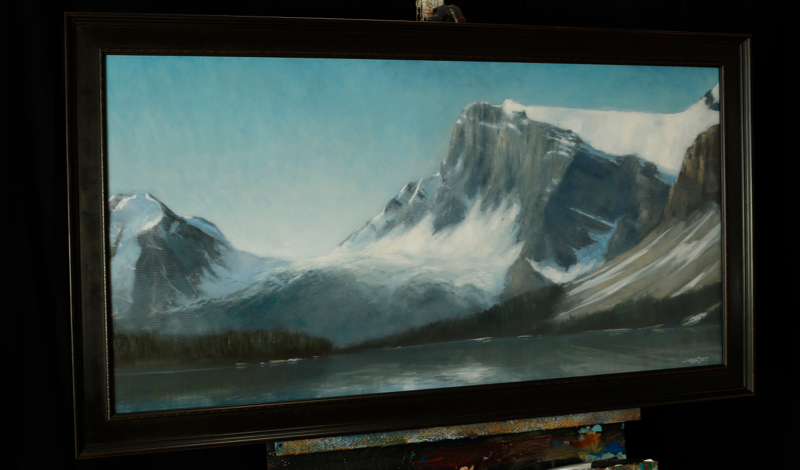It was another night of men’s league golf, and we were playing two guys I had never met before. I teed the ball up on a tee that is painted white with a yellow stripe two thirds of the way down. The stripe acts as a guide so I tee the ball up the same height every time. It just gives you a little extra consistency. I looked down the fairway, then back down at my ball. I took a practice swing to warm up my muscles and to make sure I had the right feel and pace to my swing. I gave the club a little waggle to make sure I had the face lined up with where I was aiming. I was ready. I coiled back and swung through the ball and pounded it 300 yards down the fairway.
“Geez, nice drive! I don’t want to have to follow that up,” one guy says with a little chuckle. It’s a nice compliment to get from a fellow golfer. To have someone give you nice feedback helps boost confidence.
As we walked onto the green the guy asks me “So what do you do for a living?”
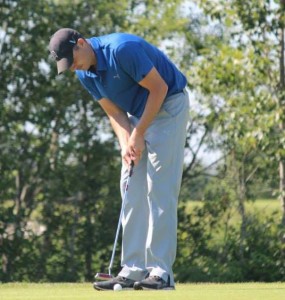 Ahhhhh, the dreaded question. The one I hated to answer. Sure I’ll step up and crush a ball down the fairway, but when it comes to explaining what I do I’d rather crawl into a deep dark hole with spiders crawling around in it. Spiders freak me out by the way.
Ahhhhh, the dreaded question. The one I hated to answer. Sure I’ll step up and crush a ball down the fairway, but when it comes to explaining what I do I’d rather crawl into a deep dark hole with spiders crawling around in it. Spiders freak me out by the way.
“I’m an artist, I sell my work and teach people how to paint.” I say in a semi monotone voice, looking off into space.
“Oh… so do you do anything else? Or?”
Oh no, the dreaded follow up question. The, “are you a broke lazy bum?” follow up question. At least that’s how I always used to interpret it.
“Nope, I’m a full time artist.” I say somewhat awkwardly and abruptly and a bit defensively.
“That’s great.” They say, reading my body language that I really don’t want to talk about it.
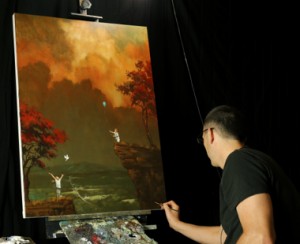
That was years ago. That was how I reacted to people asking me what I did for a living. I live in a very rural area and there isn’t a whole lot of art, aren’t any real art galleries or art societies or anything like that. There is also a scarcity of jobs. We think of our area as a place that is in a constant state of recession. So when I would tell people I was an artist that made a living, especially in the early years, people reacted with a non-believing tone. I assume they thought my fiance made a bunch of money and let me just hang out at the house in my underwear playing nerf basketball all day. I couldn’t really blame them. I probably would have reacted the same way if I wasn’t a full time artist and heard someone say they were, in our area.
After a few years of answering the dreaded question with an awkward leave me alone attitude, I decided I needed to be more confident with how I described what I do. After all, I was making a living and even if people didn’t believe me I could at least act believable. So I started welcoming the question. The only way I changed my answer was in the tone of my voice, and my body language. Even with the dreaded follow up “are you really just a lazy bum who lives in your mothers basement eating cheetos” question, I would answer with a confident happy tone. It made the interaction much better, and I would go into much more detail with what I do. People are very supportive if you let them be supportive.
CHECK OUT MY LATEST OIL PAINTING LESSON CANADIAN ROCKIES HERE!
So this brings me to something I’ve learned at workshops. I like to walk around at my painting workshops and check on how people are doing on their paintings. Sometimes I’ll walk up behind them and ask, “so how are you doing?” I always get a variety of responses to this question. Sometimes people will say, “pretty good, but I don’t really like this part here, though…” At which point I will discuss what they can work on to make that area better in their eyes. Sometimes I’ll get the response, “I’m not really sure, what do you think?” at which point I’ll discuss the areas I think they are doing really well in, and some areas they should focus on and how to improve areas that aren’t translating well. Then I get the dreaded response, “It sucks, I hate it, it’s terrible.” At that point I explain how there are areas that look really good and say keep doing more of that! Then I say why I think some areas aren’t looking right to them, and what they can do to work on it. “I dunno, I’m just going to throw it away when I get home.”
All three of those responses are very similar, except the attitude and delivery is different. Person one had areas they really didn’t like, but their attitude was more positive and receptive. They understood that painting is a process and you have to climb over obstacles to reach the next level in ability. Person two wasn’t happy with their painting but they weren’t sure why and wanted guidance. They weren’t non-confident, but they weren’t confident either, but their attitude was good and willing to work. Person three wasn’t as receptive to learning because they allowed their frustration to take over, they were defeated, and not as receptive to getting through the struggle.
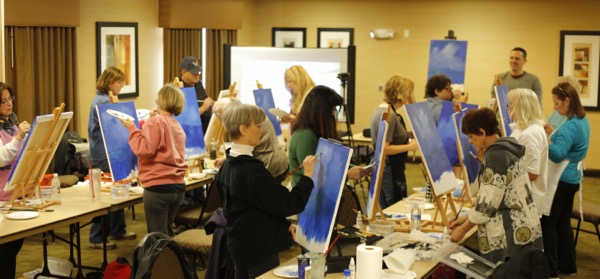 CLICK HERE TO JOIN A WORKSHOP IN YOUR AREA!
CLICK HERE TO JOIN A WORKSHOP IN YOUR AREA!
I have been person three before. In painting and in life. My old answer to “what do you do for a living?” was a person three attitude. As for painting, trust me, I’ve wanted to take a majestic swan dive off a 10 story building into a pile of reject paintings before. One thing is for sure, I’m really confident that I’d make that swan dive look like an olympic worthy flight into some horrible paintings.
The only way I’ve gotten better at painting is by having a positive attitude with it. I started to enjoy the struggle, knowing that it is just part of the journey to better work. Frustration is always going to be part of the equation. How you deal with it will determine the path you go on. The wrong attitude will lead you to the swan dive of destruction, but an accepting good attitude will lead you to being a better artist.
I have always found that those who are really receptive, and have “I can kick this paintings butt” attitudes pick up the most tricks, have the most “ah ha” moments, and progress the fastest. You can see it within a two day period. It’s pretty amazing.
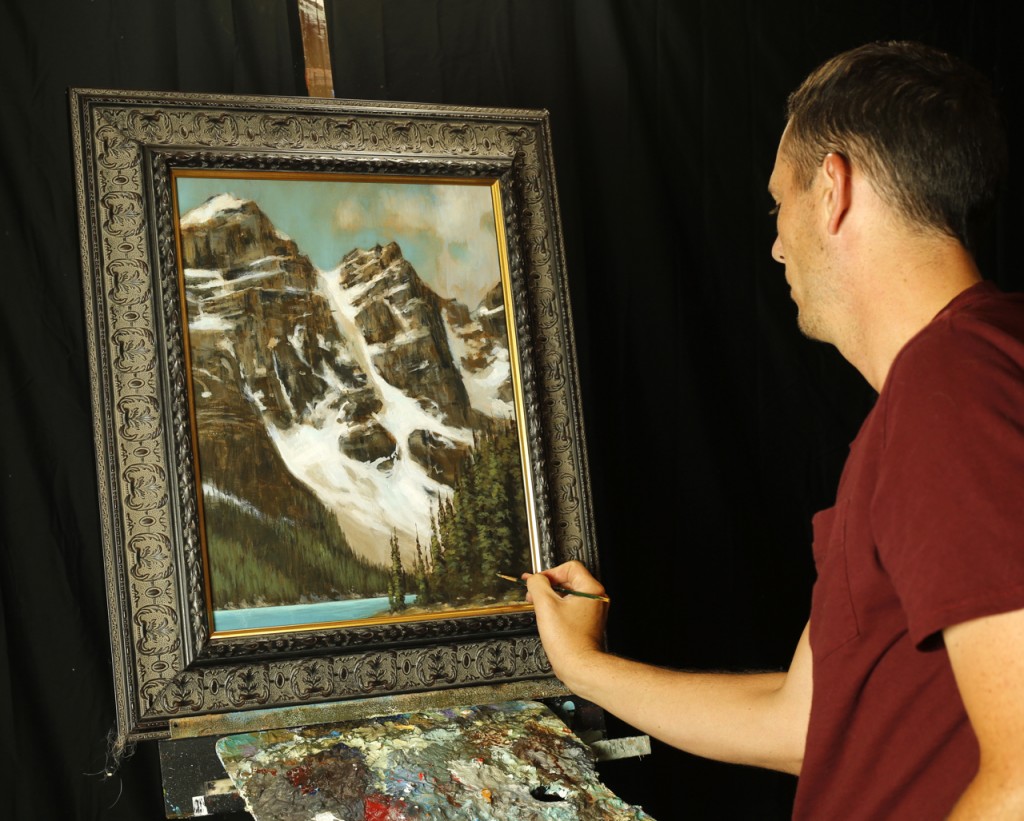 I’m usually pretty good at helping people get through their frustration and lows, but I have to work a lot harder to get some people out of the slump. It’s my job to try and make everyone happy so I try really hard at it. But I can promise you one thing. If you decide to find the good things in every painting you do you will progress faster than you can imagine. I’m going to compare this to golf again for a moment. If you look down the fairway and think “I better not slice it again, I can’t go out of bounds this time,” you’ll most likely slice it and go out of bounds. If you look at your painting and see only the things you did that you don’t like and never recognize the good things, you’ll keep making the same mistakes over and over. It’s good to know where you went wrong, but you just have to recognize it and move on and focus on the positives.
I’m usually pretty good at helping people get through their frustration and lows, but I have to work a lot harder to get some people out of the slump. It’s my job to try and make everyone happy so I try really hard at it. But I can promise you one thing. If you decide to find the good things in every painting you do you will progress faster than you can imagine. I’m going to compare this to golf again for a moment. If you look down the fairway and think “I better not slice it again, I can’t go out of bounds this time,” you’ll most likely slice it and go out of bounds. If you look at your painting and see only the things you did that you don’t like and never recognize the good things, you’ll keep making the same mistakes over and over. It’s good to know where you went wrong, but you just have to recognize it and move on and focus on the positives.
I promise you. This type of attitude will make you a better artist. You’ll improve a lot faster, and you will feel a lot happier too.

